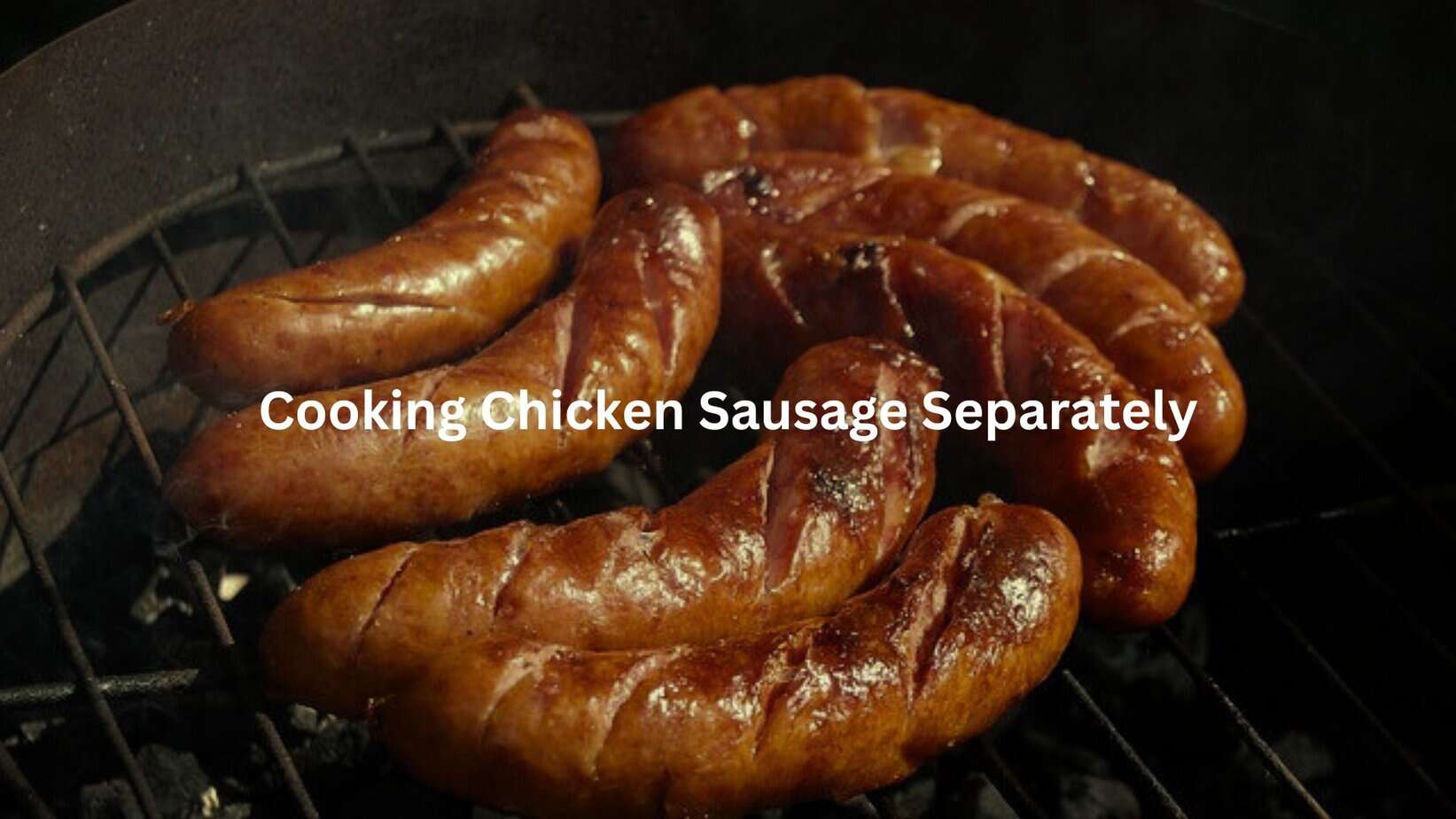Start with the sizzle. That first whiff of onions and chicken sausage browning in a skillet, it always reminds me of slow mornings at my aunt’s place in New Haven. You wake up to the soft clatter of a spatula, the kitchen window cracked for fresh air, and you know something good’s coming. Chicken sausage hash isn’t fancy, but it’s honest. It’s the sort of meal that feeds people, not just appetites.
Key Takeaway
- Chicken sausage hash is endlessly adaptable, fitting whatever’s in your fridge or pantry.
- A single skillet and some patience yield deep, layered flavors with minimal cleanup.
- Balances protein, vegetables, and potatoes for a hearty meal at any time of day.
Key Ingredients and Their Roles
Chicken sausage hash is a lesson in making do with what you’ve got. But every pan starts the same way: with a few familiar parts playing off each other.
Chicken Sausage Varieties and Preparation
High protein chicken sausage, honestly, is the backbone. It’s lighter than pork but still brings substance. With 30–40 g of protein, chicken sausage hash supports muscle health and keeps you full. A single skillet meal saves time, cuts cleanup, and lights up your weeknight routine, one-pot cooking has been a staple for centuries. (1) Sweet Italian, apple-flavored, or just simply seasoned, each kind lends something different. I’ve tried ones with fennel, others with smoky paprika, and even a maple-laced version that almost made hash feel like dessert.You might slice links into coins, crumble bulk sausage, or even halve them lengthwise for more sear. Browning matters. Let them get some color in the pan, because that’s where the flavor starts. Once, when I rushed and skipped this step, everything tasted flat. Never again.
Potato Choices and Cooking Techniques
Potatoes make hash, well, hash. Yukon Golds give a creamy bite, white potatoes crisp up well, and sweet potatoes bring a honeyed edge. My cousin swears by boiling diced potatoes just until fork-tender before frying, so you get that golden crust without hard centers. Me, I prefer letting raw cubes sizzle slowly in oil, lid on, turning them until the edges get crisp and the insides turn soft. If you’re in a hurry, parboil first. If not, let the pan do its work.
Vegetables and Flavor Enhancers
Hash is where vegetables get to shine. Most days, onions and bell peppers are the backbone. Sometimes I’ll add kale for bitterness or zucchini for its softness. Apples work too, especially if you use apple chicken sausage. They melt in, sweet and tart.Seasonings change everything. Vinegar, just a splash, wakes everything up. Mustard adds bite. I toss in thyme, garlic, a pinch of paprika, maybe some oregano or cinnamon if I’m feeling nostalgic. Red pepper flakes for heat, harissa when I want smoke. It’s all personal.Optional toppings? Eggs, always. Fry or poach them right in the pan. Herbs like parsley or chives. Hot sauce, if you’re into that.
Step-by-Step Preparation Process

Credits: Cookin’ with Tee
Making chicken sausage hash isn’t hard, but it pays to do things in order. I’ve learned this the messy way, scraping burned potatoes off a skillet in college.
Preparing Potatoes and Vegetables
Start with the potatoes. Dice them small, about half an inch, so they cook fast. You can boil them for five minutes, drain, and set aside. Or, just toss them into a hot skillet with oil and let them brown, turning every few minutes, for about 10 to 15 minutes. You want them golden and just cooked through.While potatoes cook, prep the vegetables. Chop onions, bell peppers, maybe a handful of kale or a small apple. Sauté onions first until they’re soft and translucent. Then add your other vegetables, cooking until everything’s just tender. If you add apples, put them in last so they don’t turn to mush.
Cooking Chicken Sausage Separately

Sausage cooks quickly. I slice mine into half-inch rounds and brown them in a dry skillet. Five minutes, maybe six, until the edges are crisp and the centers are cooked through. If you’re using crumbled sausage, break it up with a spoon as it cooks. The goal is brown bits, not steam.
A trick: after browning, I sometimes add a tablespoon of water or broth and scrape the pan. This keeps the sausage juicy and grabs all the flavor left behind.
Combining and Simmering Ingredients
Now, everything goes back in the pan. Potatoes, vegetables, sausage. Stir together. Sprinkle in your seasonings, salt, pepper, thyme, maybe paprika. A dash of vinegar or a spoonful of mustard gets stirred in now. Pour in a quarter cup of chicken broth if you have it, just enough to loosen the bits stuck to the pan.Turn down the heat. Let everything simmer for five minutes, uncovered. The flavors meld, the vegetables finish cooking, and you get those crispy edges.
Serving Suggestions
You can eat hash as is, but it’s better with eggs. It makes a great egg breakfast when you crack a few over the top, cover, and let them steam until the whites set.Crack a few over the top, cover, and let them steam until the whites set. Or fry eggs in another pan and slide them on before serving. Scatter fresh herbs or drizzle hot sauce over everything. Serve right from the skillet, family-style.
Flavor Profiles and Creative Variations
Chicken sausage hash tastes like comfort. But you can tweak it a hundred ways.
Balancing Savory, Sweet, and Tangy Notes
The potatoes are earthy, soaking up everything else. Sausage brings salt and spice. Bell peppers and apples add sweetness. Vinegar and mustard cut through the richness. Fresh herbs brighten the whole thing.I’ve tried adding cinnamon or ginger for warmth. Harissa or red pepper flakes for fire. A splash of cider vinegar or lemon juice at the end makes it pop.
Popular Variations and Ingredient Swaps
- Add bacon. Chop and cook it first, use the fat for the potatoes.
- Swap chicken broth for water to deepen the poultry flavor.
- Toss in greens: kale, spinach, or Brussels sprouts, shredded thin.
- Try sweet potatoes or butternut squash for fall. They get caramelized, almost candy-like.
- Mushrooms, tomatoes, zucchini, or cauliflower give more texture. I once added leftover roasted broccoli and it worked.
- Use whatever’s in the fridge. Hash forgives.
Nutritional Benefits and Practical Advantages
Chicken sausage hash isn’t just filling. It’s balanced, too. A typical serving (~225 g) of chicken sausage hash delivers around 310–377 calories, with 30–39 g protein, 27–35 g carbohydrates, 8–9 g fat, and 5–6 g fiber. (2)
Nutritional Breakdown
A serving runs about 400 to 450 calories, give or take. For diabetics, it’s a balanced choice, you get protein from the sausage and eggs, carbs from the potatoes, fiber and vitamins from the vegetables. Cooking oils add a little fat, but not too much if you go easy.Throw in kale or peppers and you’re getting vitamin C, A, potassium, and iron. Apples bring fiber and a bit of sweetness without much sugar.
Convenience and Versatility
- One skillet means you’re not buried in dishes.
- You can swap ingredients for whatever’s left in the crisper. No two hashes are the same.
- Morning, noon, or night, it fits. Leftovers keep well. Just reheat in a pan and add a fresh egg if you want.
- Feeds a crowd or just yourself. Easy to double or halve.
Conclusion
Chicken sausage hash isn’t a recipe as much as a method. Use what you have. Pay attention to the order, potatoes need time, sausage wants browning, vegetables soften quickly. Season as you go. Taste often.If you want a shortcut, use frozen hash browns and precooked sausage. If you want to stretch it, toss in beans or more greens. If you’re feeding picky eaters, keep the seasonings mild and let people add hot sauce at the table.Most of all, eat it hot, right from the pan. Maybe with a strong cup of coffee or a glass of cold cider. It’s simple food, made honest, and worth repeating.Try it once and see how it fits your table. Odds are, it’ll become a regular.
FAQ
What’s the best way to cook chicken sausage hash in a large skillet?
Heat a tablespoon of oil over medium heat in your large skillet. Add diced sweet potato first and cook until golden brown, about 8-10 minutes. Then add the chicken sausage and cook for another 5-6 minutes. Toss in your bell pepper and cook everything together until the sausage is heated through and veggies are tender.
Can I make sweet potato breakfast hash ahead of time for meal prep?
Yes! This breakfast hash works great for meal prep. Cook everything except the egg, then store in the fridge for up to 4 days. When ready to eat, reheat in your cast iron pan over medium heat and top with a fried egg or poached egg. You can also portion it into containers for grab-and-go breakfasts.
What’s the difference between using chicken apple sausage versus italian sausage in a hash?
Chicken apple sausage adds a subtle sweetness that pairs beautifully with sweet potato and creates a savory sweet balance. Italian sausage brings more herbs and spices with a richer flavor. Both work well, but chicken apple sausage tends to be lighter and complements the natural sweetness of the potatoes better.
How do I get my sweet potato hash golden brown without burning it?
The key is cooking in a single layer and not overcrowding your pan. Use medium high heat with avocado oil or olive oil, and resist stirring too often. Let the sweet potato pieces sit for 3-4 minutes before flipping. If they start browning too fast, reduce heat to medium and add a splash of oil if the pan looks dry.
Can I make this hash recipe dairy free and still keep it flavorful?
Absolutely! Skip any cheddar cheese and focus on seasoning with salt and pepper, garlic powder, and onion powder. The natural flavors from the chicken sausage and caramelized sweet potato provide plenty of taste. You can also add fresh herbs like thyme or rosemary for extra flavor without dairy.
What’s the best oil to use for cooking breakfast hash?
Avocado oil works excellent because it has a high smoke point and neutral flavor. Olive oil is another good choice for medium heat cooking. Both oils help achieve that golden brown color on your potatoes while keeping the dish healthy. Avoid oils high in saturated fat if you’re watching your intake.
Can I cook this sweet potato breakfast hash on a sheet pan instead of the stovetop?
Yes! Preheat your oven to 425°F and toss everything with oil on a baking sheet. Spread in a single layer and roast for 20-25 minutes, stirring once halfway through. This sheet pan method is perfect for larger batches and creates nicely caramelized edges on the sweet potato.
How do I know when to add the egg on top of my breakfast hash?
Add your egg during the last few minutes of cooking. Create a small well in the hash and crack the egg directly into it. Cover the pan and cook for 2-3 minutes for a runny yolk, or longer if you prefer it more set. The residual heat will finish cooking the egg perfectly.
What size should I cut my sweet potato for the best texture?
Cut your sweet potato into bite size pieces, about ½-inch cubes. This size cooks evenly and gets tender without falling apart. Smaller pieces cook faster but can turn mushy, while larger chunks take too long and might not cook through by the time the outside is golden brown.
Can I make this sausage breakfast hash in an air fryer?
Yes! Cut everything into bite size pieces and toss with a light coating of oil. Cook at 375°F for 12-15 minutes, shaking the basket every 5 minutes. The air fryer creates a nice crispy exterior on the sweet potato while keeping the inside tender. Add any green bell pepper during the last 5 minutes so it doesn’t overcook.
References
- https://www.eatingwell.com/gallery/8002797/best-skillet-dinners/
- https://www.eatthismuch.com/calories/breakfast-chicken-sausage-hash-4235843
Related Articles
- https://milkwoodrestaurant.com/best-high-protein-chicken-sausage/
- https://milkwoodrestaurant.com/chicken-sausage-and-egg-breakfast/
- https://milkwoodrestaurant.com/chicken-sausage-for-diabetics/
Was this helpful?

I’m Mary R. Q. , a seasoned professional chef dedicated to elevating home cooking experiences. Through my expertise in the culinary arts, I provide practical cooking tips and insightful reviews of kitchen utensils on my blog, milkwoodrestaurant.com. As a passionate advocate for transforming everyday meals into extraordinary culinary adventures, I aim to empower home cooks with the knowledge and tools they need to create delicious and memorable dishes. I’m also an author of the book “1,001 Kitchen Tips & Tricks: Helpful Hints for Cooking, Baking, and Cleaning (1,001 Tips & Tricks)” which is sold on Amazon. Join me on a flavorful journey as we explore the art of cooking and the essential tools that make it a joy.








